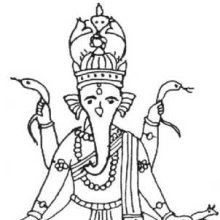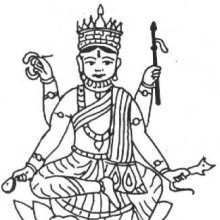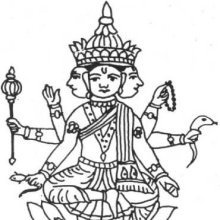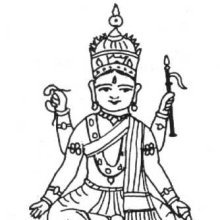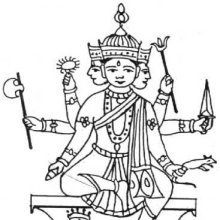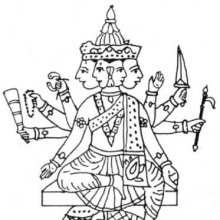Dark: 2 definitions
Introduction:
Dark means something in Hinduism, Sanskrit. If you want to know the exact meaning, history, etymology or English translation of this term then check out the descriptions on this page. Add your comment or reference to a book if you want to contribute to this summary article.
Images (photo gallery)
(+10 more images available)
In Hinduism
Shilpashastra (iconography)
Source: Shodhganga: Elements of Art and Architecture in the Trtiyakhanda of the Visnudharmottarapurana (shilpa)The Dark complexion is denoted by the Sanskrit term Śyāma, and is associated with Messengers, which follows specific guidelines in the tradition of ancient Indian Painting (citra), according to the Viṣṇudharmottarapurāṇa, an ancient Sanskrit text which (being encyclopedic in nature) deals with a variety of cultural topics such as arts, architecture, music, grammar and astronomy.—The body complexion of an elephant rider and a messenger should be śyāma i.e., dark and kapila i.e., tawny in a picture respectively. Thus the Viṣṇudharmottarapurāṇa establishes the fact that even in the pictures; the people belonging to different class and profession [e.g., messengers with a dark complexion] were projected with specific attire so that general people can equate the picture with the practical character.

Shilpashastra (शिल्पशास्त्र, śilpaśāstra) represents the ancient Indian science (shastra) of creative arts (shilpa) such as sculpture, iconography and painting. Closely related to Vastushastra (architecture), they often share the same literature.
Yoga (school of philosophy)
Source: ORA: Amanaska (king of all yogas): A Critical Edition and Annotated Translation by Jason Birch(That which is) Dark is denoted by the Sanskrit term Tamas (as opposed to Atamas—‘undarkened’), according to the Bṛhadāraṇyikopaniṣat 3.8.6.—Accordingly, while describing the absolute nature of Brahma: “Gārgi said, ‘Yājñavalkya, that which is above the sky, below the earth, between the two and called [past, present and future], is stitched and cross-stitched in what?’ Yājñavalkya said, ‘Gārgi, the Brahmins call that very [thing] the imperishable one. [e.g., It is undarkened (atamas) [...]’”.

Yoga is originally considered a branch of Hindu philosophy (astika), but both ancient and modern Yoga combine the physical, mental and spiritual. Yoga teaches various physical techniques also known as āsanas (postures), used for various purposes (eg., meditation, contemplation, relaxation).
See also (Relevant definitions)
Starts with (+41): Dark bamboo, Dark blinkblaar, Dark blue, Dark bosse, Dark green, Dark leaf malanga, Dark reddish, Dark sage, Darkar, Darkara, Darkast, Darke, Darke-pani, Darkhast, Darkhasta, Darkhastavala, Darkhastu, Darkhte-badinj, Darkhte-punbah, Darkhtenargil.
Full-text (+2612): Shyama, Krishna, Mecaka, Shyamala, Nila, Tamisra, Tamasa, Krishnapaksha, Bahula, Kalaratri, Nilambara, Ghanashyama, Niraloka, Tamahpravesha, Janmashtami, Shivacaturdashi, Asita, Andhakaramaya, Vadya, Krishnavarna.
Relevant text
Search found 355 books and stories containing Dark; (plurals include: Darks). You can also click to the full overview containing English textual excerpts. Below are direct links for the most relevant articles:
Voyage in Wonders < [January – March, 2000]
Uncertain Album < [October – December, 1999]
Death of Flora and Fauna < [January – March, 2008]
Bhagavati-sutra (Viyaha-pannatti) (by K. C. Lalwani)
Part 2 - On light and darkness < [Chapter 9]
Part 1 - Tamaskāya or bodies formed by dark matter < [Chapter 5]
Part 3 - On the state of being and state of non-being < [Chapter 3]
Guhyagarbha Tantra (with Commentary) (by Gyurme Dorje)
Text 17.5 (Commentary) < [Chapter 17 (Text And Commentary)]
Chapter 17 - Revelation of the Maṇḍala of Wrathful Deities < [Chapter 17 (Text And Commentary)]
Text 6.9 (Commentary) < [Chapter 6 (text and commentary)]
Prashna Upanishad with Shankara’s Commentary (by S. Sitarama Sastri)
Verse 1.12 < [Prashna I - The spiritual paths of the Moon and the Sun]
Vakyapadiya of Bhartrihari (by K. A. Subramania Iyer)
Verse 3.14.404-405 < [Book 3 - Pada-kāṇḍa (14): Vṛtti-samuddeśa (On Ccomplex Formation)]
Verse 3.8.32 < [Book 3 - Pada-kāṇḍa (8): Kriyā-samuddeśa (On Action)]
Verse 3.14.369 < [Book 3 - Pada-kāṇḍa (14): Vṛtti-samuddeśa (On Ccomplex Formation)]
The Jataka tales [English], Volume 1-6 (by Robert Chalmers)
Jataka 17: Māluta-jātaka < [Book I - Ekanipāta]
Jataka 406: Gandhāra-jātaka < [Volume 3]
Jataka 382: Sirikālakaṇṇi-jātaka < [Volume 3]
Related products
(+52 more products available)
